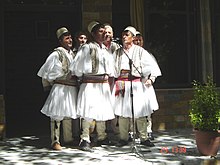Albanian iso-polyphony
| Albanian folk iso-polyphony | |
|---|---|

A traditional male group performing
|
|
| Country | Albania |
| Reference | 155 |
| Region | |
| Inscription history | |
| Inscription | 2008 (3rd session) |
Albanian iso-polyphony is a traditional part of Albanian folk music and as such is included in UNESCO's intangible cultural heritage list.
Among Albanians, all four regions of Lalëria (Myzeqe), Toskëria, Çamëria, and Labëria have the polyphonic song as part of their culture. Among Albanians a related form of polyphonic singing is also found in northern Albania in the area of Peshkopi, the Albanian communities of Kaçanik in Kosovo, the areas of Polog, Tetovo, Kičevo and Gostivar in Macedonia and the region of Malësia in northern Albania and southern Montenegro.
The region of Labëria is a particular region for multipart singing. Songs can be of two, three, or four parts. Two part songs are sung only by women. Three part songs are more diffused and can be sung by men and women. Four part songs are a Labëria specialty. Research has shown that four part songs have come after three part ones and that they are the most complex form of polyphonic singing.
The Gjirokastër National Folklore Festival, Albania, (Albanian: Festivali Folklorik Kombëtar), has been held every five years in the month of October since 1968, and it has typically included many polyphonic songs.
...
Wikipedia
